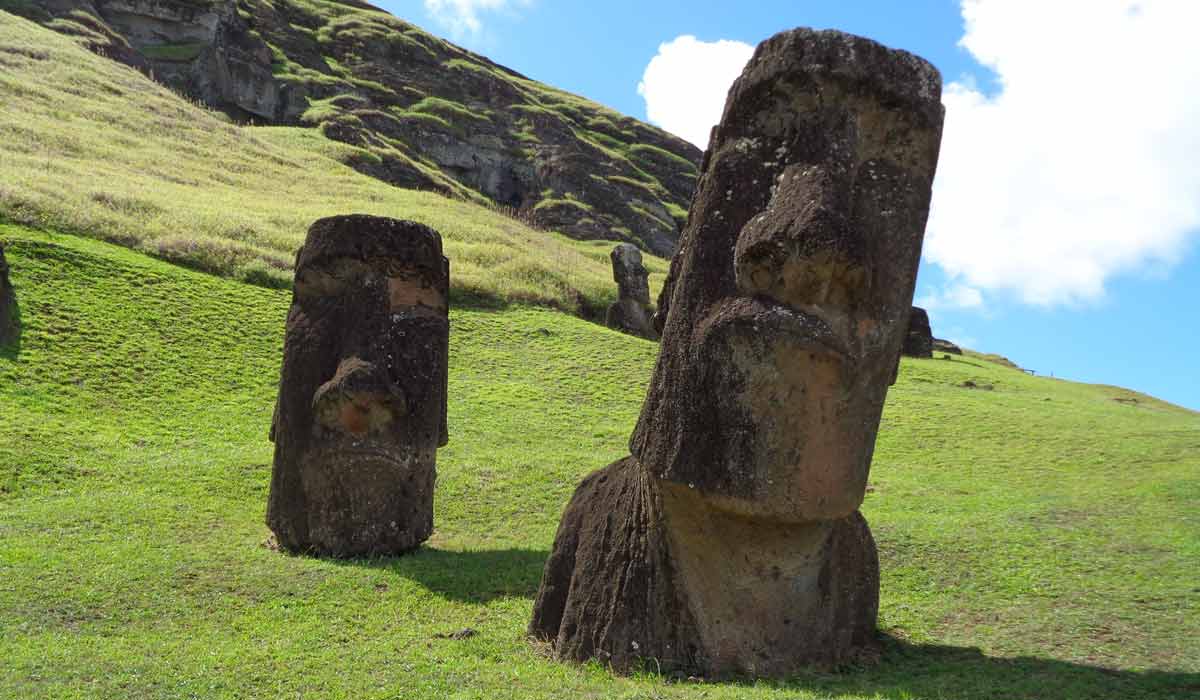This post is also available in:
More than 3.000 kilometers east of mainland Chile you can visit Easter Island, or rather Rapa Nui. In 2019 Easter Island regained its original name, but not many people know it. It is one of the most photographed places in Latin America, although it may not surprise you. What may surprise you is the history of the famous Easter Island, we tell you about it!
General information about Easter Island
Drifting in the Pacific Ocean lies Easter Island, the largest island in Chile and the most isolated inhabited place in the world. It has an extension of 163 square kilometers full of mysteries and secrets, don’t run ahead, but we already tell you that it’s worth catching a plane after doing the Torres del Paine W Trek.
The capital of Easter Island is Hanga Roa and it is the only inhabited population of Easter Island. Its original name is Rapa Nui which means big island and was given by the navigators who arrived in the territory in the seventh century.
History of Easter Island
In the 7th century AD King Hotu Matu’a of the Marquesas Islands left his land in order to colonize new territories. When they discovered the new lands they wasted no time in populating them giving rise to the Rapanui people. There was no shortage of chickens, dogs and pigs, as well as plants and fruits such as bananas and sugar cane.
On Easter Island, the population grew to 10.000 inhabitants, but of course, this led to the overexploitation of resources and the scarcity of resources: the great Rapa Nui crisis began. The situation worsened when the people rebelled and tried to put an end to the hierarchy proposed by King Hotu Matu’a.
In the 18th century the navigator Jacob Roggeween stumbled upon the island in 1722. It was specifically on April 6, the day on which the Christian community celebrates Easter and hence the name of the island. Easter Island was annexed to Chile in 1888 and Chile decided to rent it for exploitation to a British company that almost wiped out the native population, traditions, and customs Rapanui.
Easter Island was exploited until 1933 and then it was the Chilean government who administered the land. Independence came to the islanders at the end of the 20th century after two uprisings and after many comings and goings, nobody commanded them anymore!
Currently, Easter Island is a UNESCO World Heritage Site. Hanga Roa, its capital and the only inhabited population now has many more amenities than in its origins: drinking water, sewers, paved roads, etc. What luxuries! It is curious that today Chile is interested in maintaining culture, restoring buildings and recovering flora and fauna. Destroy to build, the history of the human being.
Moais: the guardians of the island
There are more than 1.000 moais on Easter Island. With a weight of 80 tons and 10 meters high, it is a mystery how they could be raised in their day without today’s technologies. Now you have to study engineering for six years!
The Polynesian natives, the conquerors, were characterized by religious cults and the importance they gave to the gods within their culture. They believed in spiritual energy called mana, which gave people powers after death and allowed them to influence events in the present.
The natives of Easter Island built the moais to commemorate, celebrate and worship their religious beliefs. These statues became the main place to carry out any celebration, including funeral rites: right at the foot of the moais corpses were left until they decomposed. Then the bones were lifted and buried under the rocky structure.
The less romantic and more practical theory says that the moais indicate the points from which to extract drinking water on Easter Island. It is a somewhat more boring explanation that assures that the moais had no defensive, decorative or ritual function.
Of all the Moais on Easter Island, you are surely looking for the one that is underwater. Well, it is not real! It is the Moai imposter and it was actually launched by Kevin Costner in 1994 for his movie Rapa Nui. Finally it was not carried out, but they left the poor Moai abandoned.
Traveling to Chile and not visiting Easter Island could be highly penalized. It’s not that you’re just passing through, but for one more plane to get to know in-depth one of the most remote places on the planet whose origin lies in underwater volcanic activity is not so much. Don’t you think?

